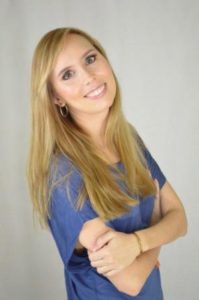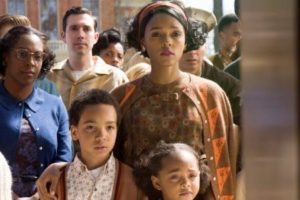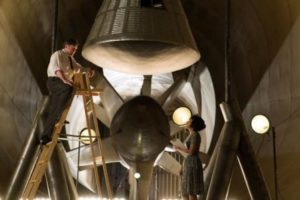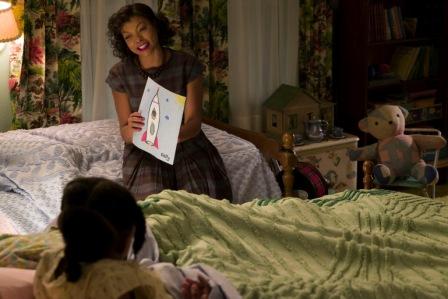
Allison Schroeder, screenwriter
In 1962, historical ground was broken in the space race in more ways than one. Amid the unrest of the Civil Rights Movement, Hidden Figures (in theaters nationwide Jan. 6) tells how a group of mathematically minded black women crossed the color line, broke through barriers for women in science, and helped NASA get the Mercury program into orbit. We spoke with Hidden Figures screenwriter Allison Schroeder about women in science and filmmaking.
R: What does a film like Hidden Figures — with its emphasis on both women in science and African American women in positions of success — mean for our culture right now?
AS: I think it’s incredibly important that we show scientists as they are in the real world —diverse! Little girls and boys are turning to film and television and asking, “What can I be when I grow up?” We need to make sure they know they can be mathematicians, scientists, explorers and innovators, no matter what their gender or race.
R: Why is it important to have women, and in particular black women, represented as powerful, intelligent and capable, and working successfully in math and science?
AS: History is filled with women and minorities who have excelled at math and science. Society just hasn’t spoken about them enough; media hasn’t depicted them enough on-screen. Most people don’t know about the women of Hidden Figures: Katherine Johnson, Mary Jackson, and Dorothy Vaughan. It’s time their stories are told (and others like them) so that women and minorities have role models and a clear example of a success story.
 R: Do you have an affinity for math and science that helped you relate to the characters? What part of the characters’ experience and situations did you relate to?
R: Do you have an affinity for math and science that helped you relate to the characters? What part of the characters’ experience and situations did you relate to?
AS: I grew up in Florida, near NASA at Cape Canaveral, where both my grandmother and grandfather worked in the 1960s and 1970s. My grandfather was an engineer on the Mercury capsules, and I remember visiting NASA and playing on an old prototype displayed in a field. I was convinced at age six that if I just pushed the right series of buttons, I’d launch into space. My grandmother was a computer programmer who worked in the Vertical Assembly Building and worked on the Apollo and Shuttle missions.
I inherited their math and science genes and spent all four years of high school in NASA NURTURE’s Math and Science Program. I’d head up to the Cape to learn binary coding and how to build a circuit board. I’d work with scientists on payload bay experiments and even boated through the swamplands to learn about environmental conservation.
After my freshman year at Stanford University, I worked for a missile launch company. They hired me to do filing; I ended up doing math and excel modeling. Some of the experiences in Hidden Figures, such as a teacher telling Mary Jackson he couldn’t teach a woman math, actually happened to me during my studies. I think people had a hard time believing I could handle the rigorous workload. The key was simply to never back down, to keep showing up, to do the work and do it well.
R: What did you learn about women in science that you feel many people don’t know?
 AS: I think many people have a certain image for women in science: a stereotype of a socially awkward geek. But many are extremely well-rounded individuals with a multitude of interests. I actually have two Stanford friends who are computers programmers by day and silk aerialist performers by night. The women of Hidden Figures volunteered at their churches, sang in the choir, led local Girl Scout Troops, and had fulfilling personal lives with wonderful children and husbands. Katherine Johnson was an amazing piano player and excelled at French.
AS: I think many people have a certain image for women in science: a stereotype of a socially awkward geek. But many are extremely well-rounded individuals with a multitude of interests. I actually have two Stanford friends who are computers programmers by day and silk aerialist performers by night. The women of Hidden Figures volunteered at their churches, sang in the choir, led local Girl Scout Troops, and had fulfilling personal lives with wonderful children and husbands. Katherine Johnson was an amazing piano player and excelled at French.
R: What was it like to be a female screenwriter on a film with powerful women at its core?
AS: I felt a huge responsibility to this story and these women. I worked very hard to write them as complex, three-dimensional, kick-ass women. At its core, this movie is about friendship — how these women helped each other achieve their goals, cheering each other onward despite the obstacles. I think we need to see more stories about women supporting women. And I tried to write the men with the same complexity, because that’s the true story. These were real, sometimes imperfect people, who came together for a common goal.
 R: How do you feel about the term “female screenwriter”?
R: How do you feel about the term “female screenwriter”?
If I’m being introduced at a meeting or event, I’d prefer to just be called a “writer” with no gender specification. But if someone’s making a point, I’m happy to be part of the conversation. I’m Co-Chair of the WGA’s Committee of Women Writers and serve on the WGA’s Diversity Advisory Group, so I advocate for female and diverse writers all the time. We need more diversity in front of and behind the camera. I don’t shy away from the conversation. I plunge straight into it.
R: How can we encourage more women to enter fields like science, math, filmmaking, or scriptwriting?
AS: By example. By talking about our own experiences and the obstacles we faced and how we overcame them. This lets others know they’re not alone, and that if they keep persevering, they can succeed. We need to lift each other up, help each other get jobs, support each other’s dreams.
R: How can a genre like science fiction help make sure that women and minorities are being represented in fiction?
AS: By making sure female characters and diverse characters are part of the stories. And not just as side characters or afterthoughts, but as leaders and heroes and evil masterminds. It’s as simple as that.
Photo Credit for movie stills: Hopper Stone